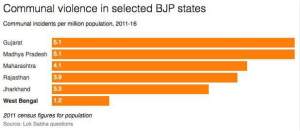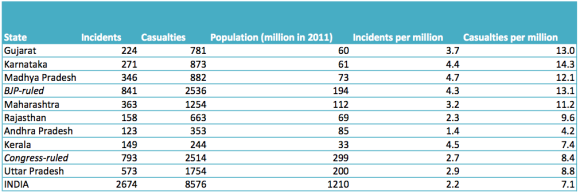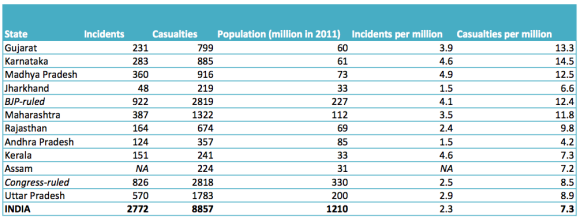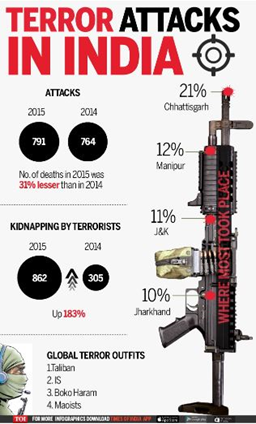Riots in Gujarat post 2002 and communal riots in BJP ruled states
This post has two articles
Gujarat not riot-free since 2002: Here’s the proof
BJP ruled states more communally violent
Gujarat not riot-free since 2002: Here’s the proof
By Amitabh Dubey
The Economist’s endorsement of the Rahul Gandhi-led Indian National Congress (INC) over Narendra Modi’s Bharatiya Janata Party (BJP) has sparked an outcry from Modi supporters. The Economist argues that there is “nothing modern, honest or fair” about promoting sectarian hatred, as Mr Modi has done, and that “it would be wrong for a man who has thrived on division to become prime minister of a country as fissile as India.”
The result has been a rehashing of the debate over Modi’s culpability in the 2002 Gujarat riots. In a 4 April rebuttal on Firstpost, Dhiraj Nayyar argues that Modi cannot be held responsible for the riots because he had been in power for only six months when the riots broke out. Mr Nayyar goes on to argue:
“Gujarat has been peaceful for 12 years after 2002, the longest period of communal peace in that state’s turbulent history. No riots broke out after the despicable events of 26/11. And when riots did break out in Muzaffarnagar last year, they were incited by the “secular” Samajwadi Party, a partner of the Congress-led UPA Government at the Centre.”
We can debate Modi’s role in the 2002 riots forever, but of one thing we can be certain: Gujarat has not “been peaceful for 12 years after 2002.” To the contrary, the state shows far higher levels of communal violence that the national average. This fact has been entirely absent from popular discourse and has allowed spin doctors to whitewash Mr Modi’s record — not in 2002 — but in as recent a period as 2010-13.
The chart below (covering the period January 2010 to October 2013) is produced using communal violence data from the Ministry of Home Affairs:
The findings are unambiguous: BJP states have a communal violence casualty rate of 12.1 per million, which is 46% higher than the 8.3 per million of their Congress-ruled counterparts. This figure is 105% higher than the 5.9 per million of regional party-ruled states (not shown in Chart 1).
Gujarat has the second highest levels of communal violence in the country, after Karnataka (which was also ruled by the BJP during the period under analysis). Someone needs to ask Mr Modi how “good governance” in Gujarat has led to an intensity of communal strife that is 83% higher than the national average and 48% higher than even riot-hit Uttar Pradesh.
Furthermore it is specious to pin the blame for the Muzaffarnagar riots on the Samajwadi Party. Modi’s right-hand man Amit Shah is talking up Jat and Hindu pride while touring Jat villages in the company of BJP legislators Hukum Singh and Suresh Rana, both accused of inciting those riots.
Harping on Modi’s possible role in the 2002 riots elides a more pressing question: why is his more recent record of keeping the communal peace in Gujarat so poor?
You can read the original blog post here.
Amitabh is co-head of the India team of an emerging market research firm and focuses on issues of politics and governance. Amitabh has previous experience as a political risk analyst and as a business journalist in India with Business Standard and Business India Television. He has degrees in economics and political science from Delhi University, the University of Chicago and Columbia University. Amitabh is based in New Delhi.
Published Date: Apr 07, 2014 10:53 am | Updated Date: Apr 07, 2014 11:48 am
SOURCE: http://www.firstpost.com/politics/gujarat-not-riot-free-since-2002-heres-the-proof-1468735.html
BJP ruled states more communally violent
Following Chris’s response to my previous post, correctly questioning whether it makes sense to use vaguely defined “incidents” to measure communal violence, it took me a while to locate better data. I found some up-to-date statistics on casualties of communal violence in a table annexed to a 10 December 2013 Ministry of Home Affairs reply to a question in the Lok Sabha. This measure, I think, better reflects the intensity of communal violence. The data cover the period 2010 to October 2013.
The findings are unambiguous: Bharatiya Janata Party (BJP)-ruled states have higher levels of communal violence than do Indian National Congress (INC)-ruled states. The BJP-ruled states in this sample have an incidence rate of 4.3 per million, which is 59% higher than the INC-controlled states. BJP states have a casualty rate of 13.1 per million, 56% higher than their Congress counterparts.
Of these states, Karnataka and Gujarat are by far the most violent (remember that Karnataka was run by the BJP during this period). Uttar Pradesh shines in comparison, and that too during a period that includes the Muzaffarnagar riots and excludes the 2002 Gujarat riots.
Someone needs to ask prime ministerial aspirant Narendra Modi how “good governance” in Gujarat has led to a communal incidence rate 68% higher than the national average and an intensity of communal strife that is 83% higher.
Needless to say the original premise of the Mail Today story is bass ackwards.
Update on Feb 17
Thanks to Tripti Lahiri for pointing out that the 2012 Kokrajhar riots in Assam are inexplicably excluded from the Home Ministry’s table, an omission that others had also noted last year.
To bring Assam in we need to broaden the analysis to all states that had at least one communal violence death during the period under study, which in this instance are Congress-ruled Assam and BJP-ruled Jharkhand.
This adjustment lowers the casualty rate of the BJP states to 12.1 per million, which is still 46% higher than the 8.3 per million of their Congress-ruled counterparts. The casualty rate for states run by regional parties (Bihar, Odisha, Tamil Nadu, Uttar Pradesh and West Bengal) is lower still, at 5.9 per million.
Update on May 7
The following table incorporates fresh numbers provided by a Ministry of Home Affairs reply to a Feb 5 Rajya Sabha question with data for all of 2013 (the earlier table covered the period between 2010 and October 2013):
The conclusion is unchanged: BJP-ruled states are still more communally violent than others. BJP states have a casualty rate of 12.4 per million, 45% higher than Congress-ruled states and 70% greater than the national average. Gujarat has a communal incidence rate 70% higher than the national average and a casualty rate that is 82% higher.
SOURCE: https://chunauti.org/2014/02/15/bjp-ruled-states-more-communally-violent/





